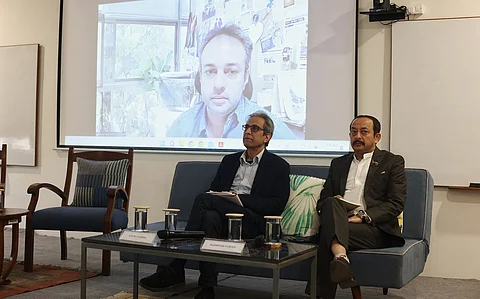

A session at the ongoing Anil Agarwal Dialogue 2025 on the state of extreme weather in India and South Asia has painted a worrying picture of what lies ahead for the country.
Titled In the red: Why are our cities heating up–urban heat and warm nights, the session discussed the phenomenon of increasingly warm nights and urban heat in the subcontinent due to the warming of the planet and its effects on public health and livelihood.
Experts including Roxy Mathew Koll, Climate Scientist, Indian Institute of Tropical Meteorology, Pune; Anand Sharma, former Additional Director General, India Meteorological Department; Rajneesh Sareen, Programme Director, Sustainable Urbanisation, Centre for Science and Environment (CSE), Amit Khurana, Programme Director, Sustainable Food Systems, CSE and D Venugopal, Deputy Director, Crop Insurance, Department of Agriculture, Government of Andhra Pradesh discussed various aspects of the subject at the ongoing conclave organised by CSE and Down To Earth.
Koll set the stage with his opening remarks about Indian and South Asia. India, he said, was the poster child of extreme weather events because the country lies in the tropics where there is a lot of solar energy. “The oceans are warming fast, affecting the monsoons,” he noted.
Three climatic factors — anticyclones, western disturbances & warming — are creating unbearable conditions in many states in India.
Koll also drew attention to oceanic heatwaves and the Indian Ocean. The world’s third-largest ocean, he warned, might be in a permanent heatwave condition by 2050. “Right now, the ocean sees 20-50 days of heatwaves and this could go up to 220-250 days,” Koll said.
Following Koll’s lead, Anand Sharma and Rajneesh Sareen pointed to the worrying situation regarding heat across India’s urban areas and booming cities.
“Over the past decade, even our nights are getting warmer—Rising minimum temperatures, increased cloud cover, aerosols and even volcanic activity are reshaping our planet,” said Sharma.
As cities grew and infrastructure expanded, the so-called ‘urban heat island effect’ will increase in the future, he added. This would particularly affect the vulnerable groups within Indian society.
Sareen warned that cities were not cooling down at night, with the urban heat island effect growing more profound. “The rise of monolithic concrete structures worsens thermal comfort, as concrete performs poorly in heat management,” he pointed out.
This was followed by a discussion between Khurana and Venugopal on climate insurance titled Insurance – can it keep pace with the increasing scale and impact of extreme weather?
Agriculture is the biggest employer in India. However, according to Khurana, the rise in minimum temperatures is one of the most important factors contributing to risk in terms of climate change impacts on agriculture.
Farmers in the country’s high-risk districts, he revealed, are shouldering high premiums despite greater climate vulnerability, yet receiving fewer claim benefits.
On his part, Venugopal said farmers lack clarity on insurance. “Enhancing transparency and improving the accuracy of yield and weather data would greatly benefit crop insurance mechanisms,” he added.
Over 80 journalists from across the country are participating in the Anil Agarwal Dialogue, organised every year by CSE at its facility, the Anil Agarwal Environment Training Institute, located in Nimli, Rajasthan.